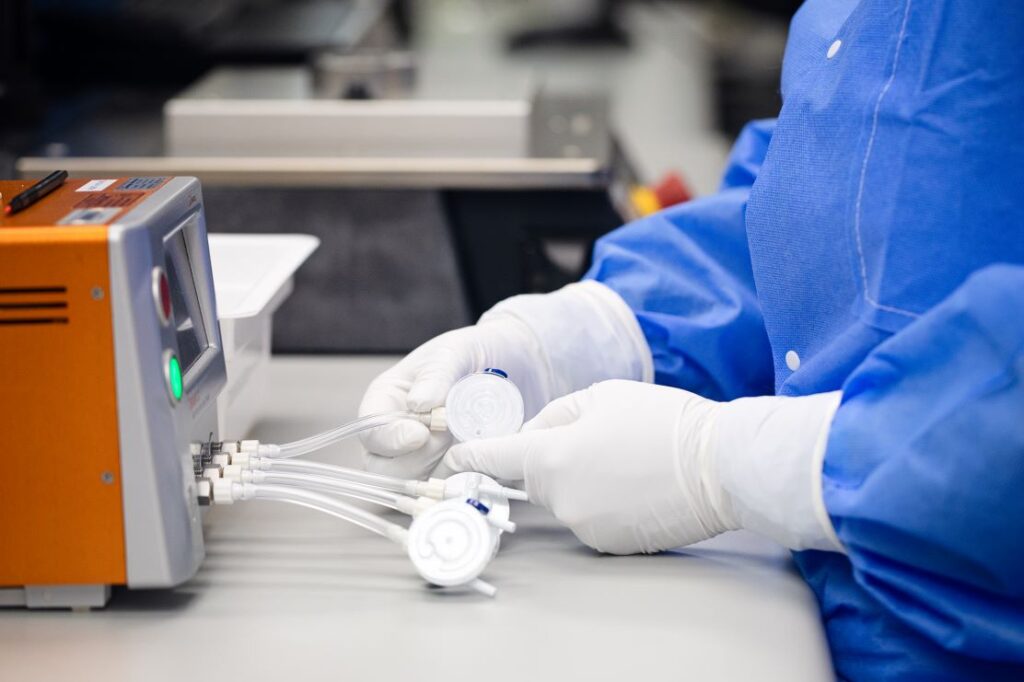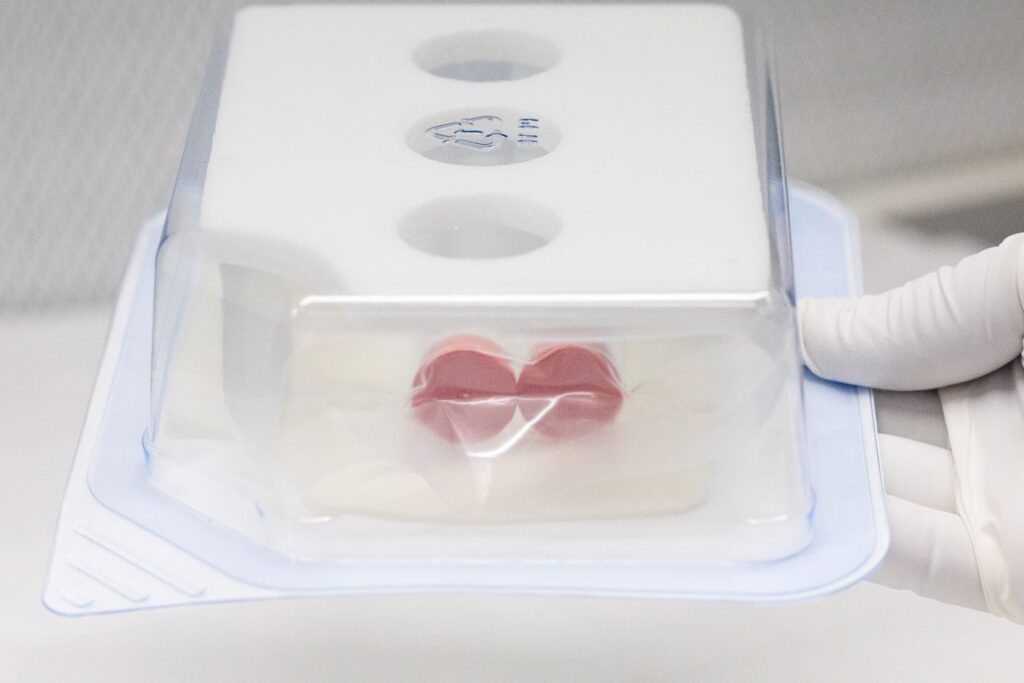A robust packaging design process transforms ideas into practical solutions by integrating packaging design and manufacturing practices that balance innovation, cost control, and regulatory compliance. From early-stage packaging development to final production, each phase plays a critical role in ensuring medical devices remain sterile, effective, and safe throughout their intended shelf life and use.
In this guide, we’ll explore each stage of the journey from concept to completion. By the end, you’ll have a clear understanding of how a structured, well-executed process turns creative concepts into high-quality medical device packaging solutions that protect patients and meet global regulatory standards.
The Packaging Design Process
The packaging design process for medical devices is highly structured and governed by international standards such as ISO 11607-1/2. While the specifics may vary depending on device classification and sterilization method, a robust process often follows these stages:
- Research and Strategy
This phase defines project scope, product requirements, and regulatory expectations. It aligns packaging with the device’s use case, considering sterilization method, expiration dating, barrier performance, and labeling compliance. - Material Selection
Choosing the right packaging materials is essential for ensuring sterility and patient safety. Common options include:- Medical-grade paper and Tyvek® for breathable pouches and lids.
- Medical-grade films with strong barrier properties against oxygen and moisture.
- Foam solutions like polyethylene foam, fabricated foam, or molded polyurethane for protective secondary or transport packaging.
- Corrugated materials for shipping and distribution.
- Design Development
The structural and functional elements of medical device packaging are developed simultaneously. Functional structural design ensures sterile barrier integrity, ease of aseptic presentation, and compatibility with sterilization. Digital prototypes and virtual reality tools allow packaging engineers to evaluate usability and performance before physical samples are created. - Testing and Validation
Unlike other industries, medical device packaging must undergo rigorous validation testing to prove that it consistently maintains sterility and integrity. These processes ensure compliance with FDA 21 CFR Part 820 and international requirements, and they include:- Structure integrity tests (compression, vibration, impact).
- Seal strength testing to verify sterile barrier integrity.
- Aging studies to simulate shelf life (per ASTM F1980).
- Distribution simulations to test performance across complex supply chain conditions.
- Production Preparation
Once validated, the design transitions into manufacturing planning. This stage considers the appropriate manufacturing techniques, such as:- Automated assembly of sterile barrier pouches and trays.
- Time-Motion studies to identify the optimal production layout
- Integration of protective foams (closed cell foam, expanded polystyrene, interior foam) for shipping stability.
Packaging Development: Turning Concepts Into Reality
After design and validation, packaging development refines the solution into a fully production-ready format. This is where engineering precision meets manufacturing process control, ensuring scalability while meeting regulatory demands.
- Structural Engineering
Engineers ensure manufacturability, durability, and compliance with ISO standards. Decisions may involve whether to use corrugated construction for secondary shippers, polyurethane foam for cushioning, or barrier films for sterile containment. - Eco-Friendly Solutions
Sustainable options may be explored using plant-based resins, organic compounds, or recycled plastics. However, compatibility with the sterilization method must always be taken into account to ensure the sterility of the device is maintained. With this said, in the U.S., only 13% of plastic packaging is recycled, while globally that figure is just 9%, so there is a significant opportunity to continue to improve. - Technology-Enhanced Prototyping
3D printing, digital printing, and virtual reality help stakeholders test usability and functionality before mass production. For example, 3D-printed tray designs allow verification of device fit and presentation, reducing rework in later stages.
Packaging Design & Manufacturing Across Medical Device Applications
While the principles of packaging design and manufacturing are universal, medical devices require packaging systems that address patient safety, sterilization compatibility, and strict regulatory oversight. The type of device, its level of invasiveness, and its delivery method all influence the packaging design process and the downstream packaging development phase.

Sterile Barrier Systems
Most medical devices depend on sterile barrier packaging to preserve sterility until the point of use, employing solutions like pouches, trays, and lidded containers manufactured under ISO 13485 standards. A usability study involving 40 clinical nurses and 14 devices revealed that pouch and tray configurations outperformed vent bags, and double-layer SBS configurations reduced aseptic presentation failures compared to single-layer systems.
Protective Transport Packaging
Secondary and tertiary packaging play a critical role in ensuring devices arrive intact through complex distribution networks. Corrugated construction, combined with protective inserts made from polyethylene foam, molded polyurethane, or fabricated foam, reduces vibration, shock, and compression risks during shipping. For high-value or delicate devices, closed-cell foam or expanded polystyrene may be integrated into mass shippers to provide additional stability.
Kits and Combination Products
Medical kits, surgical packs, and drug-device combination products introduce added complexity to the packaging design process. Engineers must account for multiple sterile and non-sterile components within the same package. Functional structural design ensures each component is adequately protected and accessible while maintaining overall system integrity.
Key Packaging Materials and Technologies for Medical Devices
The effectiveness of medical device packaging depends heavily on selecting the right packaging materials and leveraging advanced technologies to meet strict standards.
Foam and Cushioning Materials
- Polyethylene Foam – Lightweight and durable, often used for reusable transport packaging.
- Closed Cell Foam – Provides superior moisture resistance and shock absorption.
- Molded Polyurethane & Fabricated Foam – Custom-shaped inserts designed for specific devices, ensuring consistent positioning and protection.
- Expanded Polystyrene (EPS) – Common in validated shipping systems for heavy or fragile devices.
Corrugated and Paper-Based Packaging
Corrugated materials are the standard for distribution packaging. In medical applications, they are often paired with validated inserts to meet distribution simulation testing requirements. Their recyclability also aligns with sustainability initiatives.

Typical Medical Device Packaging Materials
Plastics dominate sterile packaging, accounting for over 45.5% of market share in 2023, due to their light‑weight, moldable, and sterilization‑friendly nature. Additionally, paper & paperboard are the fastest‑growing segment (12.3% CAGR), with thermoformed trays (26.9% market share in 2023) particularly in demand.
Printing, Labeling, and Finishing
Labeling is a critical component of medical device packaging, governed by UDI requirements, expiration dating, and storage instructions. Digital printing ensures accuracy, graphic packaging precision, and color consistency—all essential for reducing errors. Unlike retail packaging, the emphasis is not on shelf appeal but on clarity, compliance, and patient safety.
Manufacturing Process Considerations for Medical Device Packaging
Once designs are finalized and validated, medical device packaging moves into controlled manufacturing environments. Each stage must align with FDA and ISO standards to ensure compliance and patient safety.
Supply Chain Coordination
Working with top suppliers ensures reliable access to certified materials that meet ISO and FDA requirements. A network of factories and sourcing partners helps prevent bottlenecks and maintains consistency in quality.
Automated Assembly and Production
Automated assembly improves consistency by reducing human error in processes such as tray sealing, pouch forming, and lidding. This is especially critical in internationally certified facilities, where reproducibility is essential for compliance.
Quality Assurance and Compliance
Quality control experts monitor packaging throughout the process, from material inspection to final product release. Comprehensive audits, lot traceability, and adherence to ISO 13485 ensure every package is compliant and sterile.
Customer Visibility and Service
To maintain transparency, some contract manufacturers integrate customer portals where clients can track validation progress, production milestones, and compliance reports. This ensures clear communication between packaging engineers, regulatory teams, and sales teams.
Logistics and Distribution
Validated shipping systems must account for global distribution challenges. Clear tracking of each lot throughout the distribution system is critical for traceability. Cost is also a consideration to make sure the OEM and manufacturing partner are working together to minimize shipping costs while protecting the devices being shipped.
Conclusion: Driving Innovation in Medical Device Packaging
A well-executed approach to medical device packaging design and manufacturing extends far beyond containment—it directly impacts patient safety, regulatory compliance, and healthcare outcomes. Effective packaging safeguards devices through sterilization, distribution, and storage while maintaining barrier integrity until the point of use.
In highly regulated healthcare markets, validated sterile barrier systems are essential for reducing contamination risks, avoiding costly recalls, and maintaining trust with providers and patients. Packaging and labeling failures represent a substantial share of medical device recalls—FDA data analysis indicates that roughly 19% of recalls involve labeling or packaging issues, highlighting the need for rigorous validation and testing in packaging development.
From a financial perspective, strategically designed packaging supports cost-effective manufacturing by minimizing material waste, streamlining automated assembly, and ensuring compatibility with sterilization and distribution requirements. Combined with strong package engineering expertise and a focus on functional structural design, manufacturers can consistently achieve high performance without escalating production costs.
Finally, sustainability is reshaping expectations across the medical device sector. Incorporating eco-conscious materials such as the Eco-PET Series from recycled water bottles or packaging components derived from organic compounds positions manufacturers as forward-thinking partners to healthcare systems committed to reducing environmental impact.
Ready to Elevate Your Medical Device Packaging?
If you’re looking to transform your medical device packaging into a strategic advantage, PRO-TECH Design can help. With decades of expertise in packaging development, validated manufacturing processes, and compliance-driven design, we deliver solutions that meet the strictest regulatory standards while protecting patients and devices across the global supply chain.
Contact our team today to start your next project and discover how innovative medical packaging can take your product from concept to compliance success.
FAQs
- How does packaging development differ from packaging design and manufacturing?
In the medical device sector, packaging development involves refining designs for compliance, validating material choices, and preparing for regulatory testing. Packaging design and manufacturing, by contrast, includes both the creative and technical processes of producing sterile barrier systems, protective packaging, and validated distribution solutions at scale.
- What are the most common medical device packaging materials?
Common materials include medical-grade paper and Tyvek®, sterile barrier films, polyethylene foam, molded polyurethane, fabricated foam, expanded polystyrene (EPS), and corrugated materials for shipping.
- How do manufacturers ensure structural integrity and sterility?
Manufacturers conduct structure integrity tests, seal strength testing, aging studies, and distribution simulations. These ensure the packaging maintains sterile barrier integrity, withstands manufacturing environments, and protects devices throughout global shipping and storage.
- What role does technology play in medical device packaging solutions?
Technologies such as 3D printing, digital printing, and virtual reality are increasingly used to create prototypes, simulate aseptic presentation, and validate usability. These tools reduce redesigns, accelerate approval timelines, and support regulatory compliance.
- How can medical device packaging remain cost-effective while meeting compliance standards?
By integrating cost-effective manufacturing methods like automated assembly, using validated corrugated construction for secondary shippers, and selecting optimized materials, manufacturers can reduce costs while maintaining compliance with ISO and FDA requirements.
- How does packaging influence the medical device supply chain?
Validated packaging ensures efficiency by reducing product damage, maintaining sterility through global distribution, and supporting compliance documentation across the supply chain.

